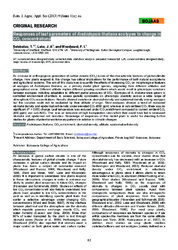| dc.contributor.author | Selebatso, T. | |
| dc.contributor.author | Lake, J. A. | |
| dc.contributor.author | Woodward, F. I. | |
| dc.date.accessioned | 2019-09-24T14:11:10Z | |
| dc.date.accessioned | 2021-02-25T09:53:35Z | |
| dc.date.available | 2019-09-24T14:11:10Z | |
| dc.date.available | 2021-02-25T09:53:35Z | |
| dc.date.issued | 2013 | |
| dc.identifier.citation | Selebatso. et al. (2013) Responses of Arabidopsis thaliana ecotypes to change in CO2. Bots. J. Agric. Appl. Sci 9 (Issue 2) 82-89 | en_US |
| dc.identifier.issn | 1815-5574 | |
| dc.identifier.uri | http://moodle.buan.ac.bw:80/handle/123456789/200 | |
| dc.description | Original Research | en_US |
| dc.description.abstract | An increase in anthropogenic generation of carbon dioxide (CO2) is one of the characteristic features of global climate change. How plants respond to this change has critical implications for the performance of both natural ecosystems and agricultural systems. The aim of this study was to quantify the effects of increasing CO2 on morphological features of ecotypes of Arabidopsis thaliana, as a primary model plant species, originating from different altitudes and geographical areas. Different altitude implies different growing conditions which would result in phenotypic variations between ecotypes including adaptation to different partial pressures of CO2. Ecotypes of A. thaliana were grown in controlled environment chambers to assess genetic constraints on phenotypic plasticity across a wide range of atmospheric CO2 concentrations. Results showed variation in stomatal density and epidermal density among ecotypes but this variation could not be explained by their altitude of origin. Most ecotypes showed a trend of increased stomatal density and epidermal cell density under elevated CO2 (800 ppm) whereas in sub-ambient CO2 there was no significant (P > 0.05) change. Leaf temperature was reduced under CO2 enrichment compared to current ambient CO2 (400 ppm) and sub-ACO2. This was an indication of high transpiration rates which then could have led to increased stomatal and epidermal cell densities. Knowledge of responses of this model plant is useful for directing further studies for plants of potential evolutionary patterns in relation to climatic changes. | en_US |
| dc.language.iso | en | en_US |
| dc.publisher | Botswana University of Agriculture and Natural resources | en_US |
| dc.relation.ispartofseries | Botswana Journal of Agriculture and Applied Sciences;Vol. 9 (Issue 1): 82-89 | |
| dc.subject | Arabidopsis thaliana | en_US |
| dc.subject | CO2 enrichment | en_US |
| dc.subject | Stomatal density | en_US |
| dc.subject | Altitude | en_US |
| dc.subject | Epidermal cell density | en_US |
| dc.title | Responses of leaf parameters of Arabidopsis thaliana ecotypes to change in CO2 concentrations. | en_US |
| dc.type | Article | en_US |

